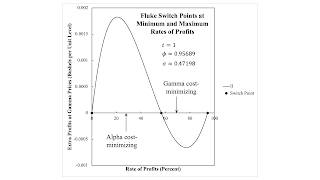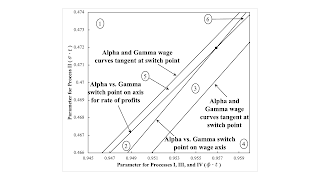Figure 1: Extra Profits at Gamma Prices for the Third Double-Fluke Switch Point This post is a continuation of this series of posts. The next double-fluke case to be considered arises for parameters on intersection of the upper and lower boundaries of regions 3 and 5. Figure 1 illustrates this case, while Figure 2 depicts local perturbations of this double-fluke case. Perturbations that lead to either of the switch points at the extremes of the rate of profits no longer being at a feasible rate result in reswitching, as in regions 3 and 5. One switch point, as in region 2, results from perturbations in which both fluke switch points no longer being at a feasible rate of profits. But consider a perturbation n which both switch points occur at a positive rate of profits below the
Topics:
Robert Vienneau considers the following as important: Example in Mathematical Economics
This could be interesting, too:
Robert Vienneau writes Austrian Capital Theory And Triple-Switching In The Corn-Tractor Model
Robert Vienneau writes Double Fluke Cases For Triple-Switching In The Corn-Tractor Model
Robert Vienneau writes The Emergence of Triple Switching and the Rarity of Reswitching Explained
Robert Vienneau writes Recap For A Triple -Switching Example
| Figure 1: Extra Profits at Gamma Prices for the Third Double-Fluke Switch Point |
This post is a continuation of this series of posts.
The next double-fluke case to be considered arises for parameters on intersection of the upper and lower boundaries of regions 3 and 5. Figure 1 illustrates this case, while Figure 2 depicts local perturbations of this double-fluke case. Perturbations that lead to either of the switch points at the extremes of the rate of profits no longer being at a feasible rate result in reswitching, as in regions 3 and 5. One switch point, as in region 2, results from perturbations in which both fluke switch points no longer being at a feasible rate of profits. But consider a perturbation n which both switch points occur at a positive rate of profits below the maximum. This example is of triple-switching in region 6.
| Figure 2: Partitions of the Parameter Space around the Third Double-Fluke Case |
| Region | Cost-Minimizing Technique | Notes |
| 1 | Alpha | No switch point. |
| 2 | Alpha, Gamma | Around the switch point, a lower rate of profits is associated with a LESS round-about technique and greater output per worker. |
| 3 | Gamma, Alpha, Gamma | Around the second switch point, a lower rate of profits is associated with a LESS round-about technique and LOWER output per worker. |
| 4 | Gamma | No switch point. |
| 5 | Alpha, Gamma, Alpha | Around the first switch point, a lower rate of profits is associated with a LESS round-about technique. Around the second switch point, a lower rate of profits is associated with LOWER output per worker. |
| 6 | Gamma, Alpha, Gamma, Alpha | Around the second switch point, a lower rate of profits is associated with a LESS round-about technique and LOWER output per worker. |
 Heterodox
Heterodox


